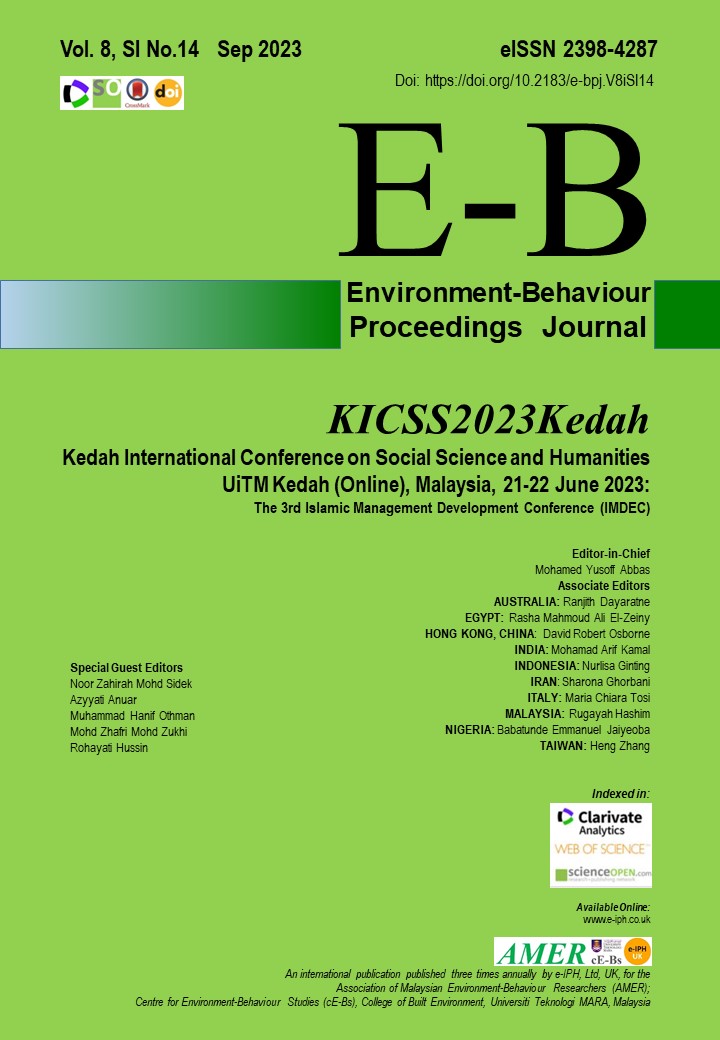Halal Food Perspectives: A cross-sectional survey of neophobic and neophilic mindsets
DOI:
https://doi.org/10.21834/e-bpj.v8iSI14.5061Keywords:
Halal, Food Neophobia, MalaysiaAbstract
This study explores the relationship between halal food and food neophobia in Malaysia. A total of 399 participants were surveyed using the Food Neophobia Scale (FNS). Neophobic individuals were most likely to be generation Z, male, had less than tertiary education, and had a salary less than RM1000. They tended to avoid food due to halal status and weird taste. The findings provide insights into the level of food neophobia among Malaysians and its impact on their acceptance of halal food. The results can aid policymakers and industry stakeholders in promoting inclusive and culturally sensitive food choices.
References
Akhtar, N., Jin, S., Alvi, T. H., & Siddiqi, U. I. (2020). Conflicting halal attributes at halal restaurants and consumers’ responses: The moderating role of religiosity. Journal of Hospitality and Tourism Management, 45, 499-510. DOI: https://doi.org/10.1016/j.jhtm.2020.10.010
Cooke, L. (2018). Genetic and environmental influences on food neophobia. In Food neophobia (pp. 237-254). Woodhead Publishing. DOI: https://doi.org/10.1016/B978-0-08-101931-3.00012-4
Fibri, D. L. N., & Frøst, M. B. (2019). Consumer perception of original and modernised traditional foods of Indonesia. Appetite, 133, 61-69. DOI: https://doi.org/10.1016/j.appet.2018.10.026
Jia, X., & Chaozhi, Z. (2021). Turning impediment into attraction: A supplier perspective on Halal food in non-Islamic destinations. Journal of Destination Marketing & Management, 19, 100517. DOI: https://doi.org/10.1016/j.jdmm.2020.100517
Jaeger, S. R. (2017). Relationships between food neophobia and food intake and preferences: Findings from a sample of New Zealand adults. Appetite, 116, 410-422 DOI: https://doi.org/10.1016/j.appet.2017.05.030
Jezewska-Zychowicz, M., Plichta, M., Drywień, M. E., & Hamulka, J. (2021). Food neophobia among adults: differences in dietary patterns, food choice motives, and food labels reading in poles. Nutrients, 13(5), 1590. DOI: https://doi.org/10.3390/nu13051590
Khan, S., Khan, M. I., Haleem, A., & Jami, A. R. (2022). Prioritising the risks in Halal food supply chain: an MCDM approach. Journal of Islamic Marketing, 13(1), 45-65. DOI: https://doi.org/10.1108/JIMA-10-2018-0206
Łoboś, P., & Januszewicz, A. (2019). Food neophobia in children. Pediatric Endocrinology Diabetes and Metabolism, 25(3), 150-154. DOI: https://doi.org/10.5114/pedm.2019.87711
Mathew, V. N. (2014). Acceptance on halal food among non-Muslim consumers. Procedia-Social and Behavioral Sciences, 121, 262-271. DOI: https://doi.org/10.1016/j.sbspro.2014.01.1127
Mascarello, G., Pinto, A., Rizzoli, V., Tiozzo, B., Crovato, S., & Ravarotto, L. (2020). Ethnic food consumption in Italy: The role of food neophobia and openness to different cultures. Foods, 9(2), 112. DOI: https://doi.org/10.3390/foods9020112
Muhammad, R., Ibrahim, M. A., Ahmad, R., & Hanan, F. (2016). Psychological factors on food neophobia among the young culinarian in Malaysia: novel food preferences. Procedia-Social and Behavioral Sciences, 222, 358-366. DOI: https://doi.org/10.1016/j.sbspro.2016.05.180
Pliner, P., & Hobden, K. (1992). Development of a scale to measure the trait of food neophobia in humans. Appetite, 19(2), 105-120. DOI: https://doi.org/10.1016/0195-6663(92)90014-W
Rabadán, A., & Bernabéu, R. (2021). A systematic review of studies using the Food Neophobia Scale: Conclusions from thirty years of studies. Food Quality and Preference, 93, 104241. DOI: https://doi.org/10.1016/j.foodqual.2021.104241
Rejeb, A., Rejeb, K., & Zailani, S. (2021). Are halal food supply chains sustainable: a review and bibliometric analysis. Journal of Foodservice Business Research, 24(5), 554-595. DOI: https://doi.org/10.1080/15378020.2021.1883214
Sofiana, R., Utama, S., & Abdur Rohim, C. (2021). The Problems of Halal Certification Regarding Consumer Protection in Malaysia and Indonesia. Journal of Human Rights, Culture and Legal System, 1(3). DOI: https://doi.org/10.53955/jhcls.v1i3.16
Takeshita, S. (2020). Halal certification or ingredient disclosure: A comparative analysis of serving food in Japanese tourist destinations. Journal of Islamic Marketing, 11(3), 765-781. DOI: https://doi.org/10.1108/JIMA-07-2018-0129
Zailani, S., Iranmanesh, M., Jafarzadeh, S., & Foroughi, B. (2020). The influence of halal orientation strategy on financial performance of halal food firms: Halal culture as a moderator. Journal of Islamic Marketing, 11(1), 31-49. DOI: https://doi.org/10.1108/JIMA-01-2018-0023
Downloads
Published
How to Cite
Issue
Section
License
Copyright (c) 2023 Nurul Aisyah Amir, Mohamad Hasif Jaafar, Shafiq Shahruddin

This work is licensed under a Creative Commons Attribution-NonCommercial-NoDerivatives 4.0 International License.





